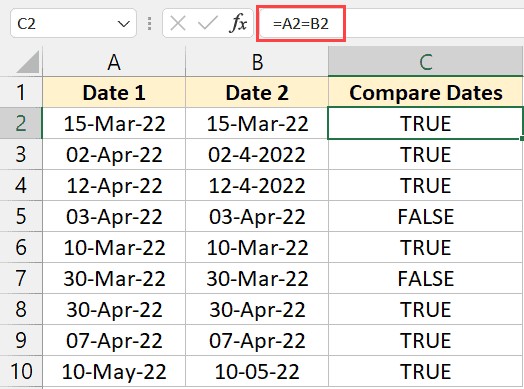Microsoft Excel is a powerful tool for data management and analysis, and dates are a fundamental data type. However, comparing dates in Excel can sometimes be tricky due to the way Excel stores and formats them. Many users encounter confusion when trying to determine if two dates are the same, or if one date occurs before or after another. This guide will provide you with a comprehensive understanding of how to effectively compare dates in Excel.
This tutorial will cover various methods for comparing dates, from simple equality checks to more complex comparisons using formulas, and how to handle dates that include time values. By the end of this guide, you’ll be equipped with the knowledge to confidently compare dates in Excel for any scenario.
Understanding How Excel Stores Dates
Before diving into comparison techniques, it’s crucial to understand how Excel handles dates and times behind the scenes. Excel stores dates as sequential serial numbers, starting from January 1, 1900, which is represented by the number 1. Each subsequent day increases this serial number by one. For instance, January 2, 1900, is 2, and January 1, 2022, is 44562.
Time is stored as a decimal fraction of a day. For example, 12:00 PM is represented as 0.5 (half of a day), and 6:00 PM is 0.75 (three-quarters of a day). When you combine a date and time, Excel uses a number with both a whole number part (for the date) and a decimal part (for the time). For example, 44562.5 represents January 1, 2022, at 12:00 PM.
This numerical representation is fundamental because it allows Excel to perform calculations with dates, including comparisons. However, it’s also the reason why different date formats can sometimes appear the same but be different values, or vice versa. Excel’s formatting only changes how the date looks, not the underlying numerical value.
It’s also important to note that Excel recognizes specific date formats. If you enter a date in a format Excel doesn’t recognize, it may treat it as text, which will prevent proper date comparisons.
Methods to Compare Dates in Excel
Now that we understand how Excel stores dates, let’s explore different methods for comparing them.
Checking if Dates are Identical
The most basic comparison is to check if two dates are exactly the same. This can be achieved using the equals operator (=). If you want to compare dates in cell A2 and cell B2 to see if they are the same, you can use the following formula in another cell (say, C2):
=A2=B2This formula directly compares the numerical values that Excel stores for the dates. It will return TRUE if the date values in both cells are identical and FALSE otherwise.
When using this method, keep these key points in mind:
- Formatting vs. Value: Dates can appear differently due to formatting but still be considered equal if their underlying numerical values are the same.
- Hidden Time Values: Dates that look the same might be different if one contains a time component that is not displayed due to formatting. For example, in the image above, rows 5 and 7 appear to have the same date, but the formula returns
FALSE. This indicates that there’s likely a time component in column B that is causing the difference, even though it’s not visible. - Valid Date Format: Ensure that both cells being compared are recognized by Excel as dates and not as text strings. If a date is entered as text (e.g., “Jan 01, 2022” without Excel recognizing it as a date format), comparisons will not work correctly.
Comparing Dates with the IF Formula (Greater Than, Less Than)
For more meaningful comparisons, you can use the IF formula along with comparison operators. The IF function allows you to perform a logical test and return different values based on whether the test is true or false.
Suppose you have two columns of dates: “Due Date” (Column B) and “Submission Date” (Column C). You want to determine if a submission was made on time (i.e., before or on the due date). You can use this formula:
=IF(C2<=B2,"In Time","Delayed")This formula checks if the date in cell C2 (Submission Date) is less than or equal to the date in cell B2 (Due Date). If it is, the formula returns “In Time”; otherwise, it returns “Delayed”.
You can expand on this using nested IF statements to handle more complex scenarios. For example, you might want to categorize submissions as “In Time,” “Grace Period,” or “Delayed,” with a grace period of 5 days after the due date. The following nested IF formula could achieve this:
=IF(C2-B2<=0,"In Time",IF(C2-B2<=5,"Grace Period","Delayed"))In this formula:
C2-B2calculates the difference in days between the Submission Date and the Due Date. This works because, as mentioned earlier, dates are stored as numbers, so subtraction yields the number of days between them.- The first
IFcondition checks if the difference is less than or equal to 0 (meaning the submission was on or before the due date), and returns “In Time” if true. - If the first condition is false, the second
IFcondition checks if the difference is less than or equal to 5 (meaning the submission was within the 5-day grace period), and returns “Grace Period” if true. - If both conditions are false, it means the submission was delayed by more than 5 days, and the formula returns “Delayed.”
Comparing Dates with Time Values
A common challenge in date comparison arises when dates also include time components. Often, cells might be formatted to only display the date part, hiding the time. This can lead to unexpected results when comparing dates that appear identical but have different underlying time values.
Consider a situation where you have dates in two columns that seem the same, but formulas using the equals operator report them as different. This is likely due to one or both columns containing time values that are not visible due to cell formatting.
In the example above, rows 5 and 7 show FALSE even though the dates appear to be the same. This indicates a difference in the underlying time values.
Using the INT Function to Compare Date Parts Only
To compare only the date portion and ignore any time component, you can use the INT function. The INT function returns the integer part of a number, effectively truncating any decimal portion (which represents the time in Excel dates).
To compare dates while ignoring time, modify the equality formula to use INT on both date cells:
=INT(A2)=INT(B2)The INT(A2) part extracts the integer part of the date value in cell A2, effectively removing the time component. Similarly, INT(B2) does the same for cell B2. By comparing these integer parts, you are only comparing the date portion, ignoring any time differences.
This approach is particularly useful when working with data imported from databases or other sources where dates might include time values that are not relevant for your comparison. It’s always a good practice to be aware of cell formatting and potential hidden time values when working with dates in Excel to avoid unexpected comparison results.
Operators for Date Comparison in Excel
Excel supports a range of operators for comparing dates, which can be used directly in formulas or with functions like IF. Here’s a summary of the operators you can use:
- Equal to:
=(e.g.,A1=B1) - Greater Than:
>(e.g.,A1>B1) - Less Than:
<(e.g.,A1<B1) - Greater Than or Equal to:
>=(e.g.,A1>=B1) - Less Than or Equal to:
<=(e.g.,A1<=B1) - Not Equal to:
<>(e.g.,A1<>B1)
These operators provide flexibility in constructing date comparison formulas to suit various needs, from simple equality checks to more complex conditional logic within IF statements.
Conclusion
Comparing dates in Excel is a fundamental skill for anyone working with date-related data. By understanding how Excel stores dates as numerical values and utilizing the techniques outlined in this guide—including direct comparison with operators, using the IF function, and employing the INT function to handle time components—you can confidently perform accurate and meaningful date comparisons. Remember to always be mindful of date formats and potential hidden time values to ensure your comparisons yield the results you expect. With practice, comparing dates in Excel will become a straightforward and efficient part of your data analysis toolkit.

